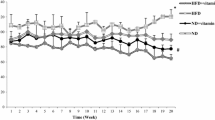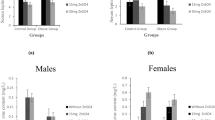Abstract
There is growing evidence that obesity can lead to neurodegeneration induced by pro-inflammatory cytokines such as tumor necrosis factor (TNF-α). Moreover, obesity is associated with reduced transport of insulin through the blood-brain barrier (BBB). Insulin deficiency in the brain especially in the hypothalamus region has neurodegenerative and obesity-promoting effects. Because of the anti-inflammatory and neuroprotective effects of vitamin D, in the current experimental study, we aimed to investigate the effects of vitamin D supplementation on neurodegeneration, TNF-α concentration in the hypothalamus, and cerebrospinal fluid (CSF) to serum ratio of insulin in high-fat-diet-induced obese rats. At the first phase of the study, the rats were divided into two groups: (1) normal diet (ND, 10% fat) and (2) high-fat diet (HFD, 59% fat) and were fed for 16 weeks. In the second phase, each group was subdivided into four groups including the following: ND, normal diet + vitamin D, HFD, and HFD + vitamin D. Weight was measured and recorded weekly. Vitamin D supplementation for 5 weeks at 500 IU/kg dosage was used. One week after vitamin D supplementation, daily food intake was recorded. At week 22, blood was collected to determine fasting serum glucose, vitamin D, and insulin concentrations, and the homeostasis model assessment of insulin resistance (HOMA-IR) was calculated. CSF samples were also collected to measure insulin concentrations, and the hypothalamus was dissected to determine TNF-α concentration. HFD significantly increased TNF-α concentrations and degenerated neurons in the hypothalamus (P = 0.02). We also observed a significant reduction of CSF-to-serum ratio of insulin in HFD group (P = 0.03). The HOMA-IR test indicated significant increment of insulin resistance in HFD-fed rats (P = 0.006). Vitamin D supplementation in HFD group significantly reduced weight (P = 0.001) and food intake (P = 0.008) and increased CSF-to-serum ratio of insulin (P = 0.01). Furthermore, vitamin D decreased insulin resistance in the HFD group (P = 0.008). Vitamin D had no significant effect on degenerated neurons and TNF-α concentration in the hypothalamus. According to our findings, vitamin D improved brain insulin homeostasis and modulated food intake and body weight in high-fat-diet-induced obese rats. Further studies are needed to better clarify the underlying mechanisms.









Similar content being viewed by others
References
Al-Timimi DJ, Ali AF (2013) Serum 25 (OH) D in diabetes mellitus type 2: relation to glycaemic control. J Clin Diagn Res 7(12):2686–2688
Andre C, Dinel AL, Ferreira G, Layé S, Castanon N (2014) Diet-induced obesity progressively alters cognition, anxiety-like behavior and lipopolysaccharide-induced depressive-like behavior: focus on brain indoleamine 2, 3-dioxygenase activation. Brain Behav Immun 41:10–21
Ashrafian H, Harling L, Darzi A, Athanasiou T (2013) Neurodegenerative disease and obesity: what is the role of weight loss and bariatric interventions? Metab Brain Dis 28(3):341–353
Begg DP, Mul JD, Liu M, Reedy BM, Dalessio DA, Seeley RJ et al (2013) Reversal of diet-induced obesity increases insulin transport into cerebrospinal fluid and restores sensitivity to the anorexic action of central insulin in male rats. Endocrinology 154(3):1047–1054
Begg DP, May AA, Mul JD, Liu M, D’Alessio DA, Seeley RJ et al (2015) Insulin detemir is transported from blood to cerebrospinal fluid and has prolonged central anorectic action relative to NPH insulin. Diabetes 64(7):2457–2466
Brown J, Bianco JI, McGrath JJ, Eyles DW (2003) 1, 25-dihydroxyvitamin D 3 induces nerve growth factor, promotes neurite outgrowth and inhibits mitosis in embryonic rat hippocampal neurons. Neurosci Lett 343(2):139–143
Castro G, Areias C, Fernanda M, Weissmann L, Quaresma PG, Katashima CK et al (2013) Diet-induced obesity induces endoplasmic reticulum stress and insulin resistance in the amygdala of rats. FEBS 3(1):443–449
Chan RS, Woo J (2010) Prevention of overweight and obesity: how effective is the current public health approach. IRJPEH 7(3):765–783
El Sayed LA, Elattar S, Eltablawy N (2012) Nerve conduction velocity of sciatic nerve in high fat diet induced obesity in rats: effect of corn oil and omega 3 fatty acids supplement. Life Sci J 9(4):458–471
Erbas O, Solmaz V, Aksoy D, Yavasoglu A, Sagcan M, Taskıran D (2014) Cholecalciferol (vitamin D 3) improves cognitive dysfunction and reduces inflammation in a rat fatty liver model of metabolic syndrome. Life Sci 103(2):68–72
Ferreira ST, Klein WL (2011) The Aβ oligomer hypothesis for synapse failure and memory loss in Alzheimer’s disease. Neurobiol Learn Mem 96(4):529–543
Ferreira ST, Vieira MNN, De Felice FG (2007) Soluble protein oligomers as emerging toxins in Alzheimer’s and other amyloid diseases. IUBMB Life 59(4–5):332–345
Ferreira ST, Clarke JR, Bomfim TR, De Felice FG (2014) Inflammation, defective insulin signaling, and neuronal dysfunction in Alzheimer’s disease. Alzheimers Dement 10(1):S76–S83
Ghasemi R, Haeri A, Dargahi L, Mohamed Z, Ahmadiani A (2013) Insulin in the brain: sources, localization and functions. Mol Neurobiol 47(1):145–171
Hadi E, Maryam N, Forough F, Marjan R, Hassan E-Z, Azita H (2016) An accessible and pragmatic experimental model of nonalcoholic fatty liver disease. MEJDD 8(2):109–115
Hallschmid M, Schultes B (2009) Central nervous insulin resistance: a promising target in the treatment of metabolic and cognitive disorders? Diabetologia 52(11):2264–2269
Heni M, Schöpfer P, Peter A, Sartorius T, Fritsche A, Synofzik M et al (2014) Evidence for altered transport of insulin across the blood–brain barrier in insulin-resistant humans. Acta Diabetol 51(4):679–681
Kern W, Benedict C, Schultes B, Plohr F, Moser A, Born J et al (2006) Low cerebrospinal fluid insulin levels in obese humans. Diabetologia 49(11):2790–2792
Kim J-S, Ryu S-Y, Yun I, Kim W-J, Lee K-S, Park J-W et al (2006) 1α, 25-dihydroxyvitamin D3 protects dopaminergic neurons in rodent models of Parkinson’s disease through inhibition of microglial activation. J Clin Neurol 2(4):252–257
Kleinridders A, Ferris HA, Cai W, Kahn CR (2014) Insulin action in brain regulates systemic metabolism and brain function. Diabetes 63(7):2232–2243
Langub MC, Herman JP, Malluche HH, Koszewski NJ (2001) Evidence of functional vitamin D receptors in rat hippocampus. Neuroscience 104(1):49–56
Latimer CS, Brewer LD, Searcy JL, Chen KC, Popović J, Kraner SD et al (2014) Vitamin D prevents cognitive decline and enhances hippocampal synaptic function in aging rats. PNAS 111(41):E4359–E4366
Lefebvre d’Hellencourt C, Montero-Menei CN, Bernard R, Couez D (2003) Vitamin D3 inhibits proinflammatory cytokines and nitric oxide production by the EOC13 microglial cell line. J Neurosci Res 71(4):575–582
Liu M, Shen L, Begg DP, D’alessio DA, Woods SC (2012) Insulin increases central apolipoprotein E levels as revealed by an improved technique for collection of cerebrospinal fluid from rats. J Neurosci Meth 209(1):106–112
McCann JC, Ames BN (2008) Is there convincing biological or behavioral evidence linking vitamin D deficiency to brain dysfunction? FASEB 22(4):982–1001
Miller AA, Spencer SJ (2014) Obesity and neuroinflammation: a pathway to cognitive impairment. Brain Behav Immun 42:10–21
Oltman CL, Coppey LJ, Gellett JS, Davidson EP, Lund DD, Yorek MA (2005) Progression of vascular and neural dysfunction in sciatic nerves of Zucker diabetic fatty and Zucker rats. Am J Physiol Endoc Metab 289(1):E113–E122
Ortega FB, Sui X, Lavie CJ, Blair SN (2016) Body mass index, the most widely used but also widely criticized index: would a criterion standard measure of total body fat be a better predictor of cardiovascular disease mortality? Mayo Clin Proc 91(4):443–455
Prüfer K, Veenstra TD, Jirikowski GF, Kumar R (1999) Distribution of 1, 25-dihydroxyvitamin D3 receptor immunoreactivity in the rat brain and spinal cord. J Chem Neuroanat 16(2):135–145
Sabia S, Kivimaki M, Shipley MJ, Marmot MG, Singh-Manoux A (2009) Body mass index over the adult life course and cognition in late midlife: Whitehall II Cohort Study. AJCN 89(2):601–607
Salehi MS, Namavar MR, Shirazi MRJ, Rahmanifar F, Tamadon A (2013) A simple method for isolation of the anteroventral periventricular and arcuate nuclei of the rat hypothalamus. Anatomy 7(1):48–51
Selhorst A (2015) The neuroprotective role of vitamin D on neurons in A central nervous system autoimmune disease. School of Health and Rehabilitation Sciences, The Ohio State University. Honors Thesis, undergraduate Biomedical Science Major
Sisley SR, Arble DM, Chambers AP, Gutierrez-Aguilar R, He Y, Xu Y et al (2016) Hypothalamic vitamin D improves glucose homeostasis and reduces weight. Diabetes 65(7):db160309
Smolders J, Damoiseaux J, Menheere P, Hupperts R (2008) Vitamin D as an immune modulator in multiple sclerosis, a review. J Neuroimmunol 194(1):7–17
Soni M, Kos K, Lang IA, Jones K, Melzer D, Llewellyn DJ (2012) Vitamin D and cognitive function. Scand J Clin Lab Inv 72(sup243):79–82
Spielman LJ, Little JP, Klegeris A (2014) Inflammation and insulin/IGF-1 resistance as the possible link between obesity and neurodegeneration. J Neuroimmunol 273(1):8–21
Thaler JP, Yi C-X, Schur EA, Guyenet SJ, Hwang BH, Dietrich MO et al (2012) Obesity is associated with hypothalamic injury in rodents and humans. J Clin Invest 122(1):153–162
Won S, Sayeed I, Peterson BL, Wali B, Kahn JS, Stein DG (2015) Vitamin D prevents hypoxia/reoxygenation-induced blood-brain barrier disruption via vitamin D receptor-mediated NF-k B signaling pathways. PLoS One 10(3):e0122821
Woods SC, Seeley RJ, Baskin DG, Schwartz MW (2003) Insulin and the blood-brain barrier. Curr Pharm Design 9(10):795–800
Zamani M, Hassanshahi J, Soleimani M, Zamani F (2013) Neuroprotective effect of olive oil in the hippocampus CA1 neurons following ischemia: reperfusion in mice. JNRP 4(2):164–170
Author information
Authors and Affiliations
Corresponding author
Ethics declarations
The study protocol was approved by the Ethics Committee of Tabriz University Medical Sciences (TBZMED.REC.1394.747).
Conflict of Interest
The authors declare that they have no conflicts of interest.
Rights and permissions
About this article
Cite this article
Nameni, G., Hajiluian, G., Shahabi, P. et al. The Impact of Vitamin D Supplementation on Neurodegeneration, TNF-α Concentration in Hypothalamus, and CSF-to-Plasma Ratio of Insulin in High-Fat-Diet-Induced Obese Rats. J Mol Neurosci 61, 247–255 (2017). https://doi.org/10.1007/s12031-016-0864-y
Received:
Accepted:
Published:
Issue Date:
DOI: https://doi.org/10.1007/s12031-016-0864-y




